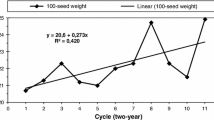Abstract
The comparative efficiency of four selection methods, viz., honeycomb (HC), pedigree selection (PS), single-seed descent (SSD) and the bulk method (BM), was assessed in three crosses of mungbean. The lines derived by each method, along with check varieties, were yield-tested in a compact family block design in F5 and F6 generations during summer and kharif of 1990. On the basis of the mean of the lines, the range, the number of superior lines over the best check, and the proportion of the top 10% lines in all the crosses and generations, the honeycomb method exhibited superiority over PS, SSD and BM for yield per plant and its component traits. PS, SSD and BM did not differ from each other. The honeycomb and SSD methods were found suitable for deriving superior lines for seed yield and pods per plant in mungbean.
Similar content being viewed by others
References
Bhatia GK (1978) Effectiveness of some early generation selection methods in barley (Hordeum vulgare L.). PhD dissertation, Punjab Agricultural University, Ludhiana
Dahiya BN, Gupta VP, Dahiya BS (1986) Comparison of single-seed descent, pedigree selection and selection for yield per se in green grams [Vigna radiata (L). Wilczek]. Crop Improv 13:82–85
Fasoulas A (1973) A new approach to breeding superior yielding varieties. Department Gene Plant Breeding, Agristotelian University of Thessaloniki, Greece. Pub No 3
Federer WT (1954) Experimental design: theory and application. Oxford and IBH, Publishers, New Delhi, India pp. 18–57
Gill KS (1980) Recommenddations for future research priorities in pulse crops. In: Gill KS (ed) Breeding methods for improvement of pulse crops. Punjab Agricultural University, Ludhiana, India pp. 428–433
Goulden CH (1941) Problems in plant selection. Proc 7th Int Genet Cong, Edinburg, pp 132–133
Haddad NI, Muehlbauer FJ (1981) Comparison of random bulk populations and SSD methods for lentil breeding. Euphytica 30:643–651
Nagi PS, Singh TH, Chahal GS (1987) Application of the honeycomb design for early generation selection in cotton (Gossypium barborium L.). Proc Ist Symp Crop Improvement, Punjab Agricultural University, Ludhiana, Fed 23–27, 1987, pp 288–294
Ntare BR, Aken'Ova ME, Redden RJ, Singh BB (1984) The effectiveness of early generation (F3) yield testing and the single-seed descent procedures in two cowpea [Vigna unguiculata (L) Wilp] crosses. Euphytica 33:539–547
Singh TH, Randhawa LS, Chahal GS (1987) Comparative efficiency of different methods and early generation selection In: Upland cotton. Proc Ist Symp Crop Improvement, Punjab Agricultural University, Ludhiana. Fed 23–27, 1987, pp 319–326
Verma MM (1980) Breeding methods used in self-pollinated crops. In: Gill KS (ed). Breeding methods for the improvement of pulse crops, pp 19–38
Voigt RL, Weber CR (1960) Effectiveness of selection methods for grain yield in soybean crosses. Agron J 52:527–530
Author information
Authors and Affiliations
Additional information
Communicated by G. S. Kush
Rights and permissions
About this article
Cite this article
Gill, J.S., Verma, M.M., Gumber, R.K. et al. Comparative efficiency of four selection methods for deriving high-yielding lines in mungbean [Vigna radiata (L.) Wilczek]. Theoret. Appl. Genetics 90, 554–560 (1995). https://doi.org/10.1007/BF00222003
Received:
Accepted:
Issue Date:
DOI: https://doi.org/10.1007/BF00222003



